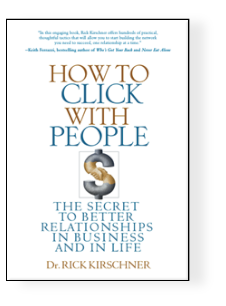Some people have charisma. People are drawn to them, listen to them, like them, and follow them. Naturopath Rick Kirschner, ND, is one of those people. In his recent book, How to Click With People (Hyperion, 2011), Kirschner endeavors to share this gift with the rest of us.
In our medical training, we learned the required interventions that will help people. We are all more or less capable of creating a treatment plan for a patient that includes suggested dietary and lifestyle changes, plus a list of daily supplements that will improve the patient’s quality of life. What we often find difficult is convincing the patient to follow any of our instructions. Compliance with a naturopathic treatment plan requires far more buy-in from the patient than they may have ever expended when seeing other primary care providers.
The challenge is often not determining what the patient should do to get well, but rather how to get the patient to take our words to heart. Thus after hearing Kirschner speak at the American Association of Naturopathic Physicians (AANP) convention this August, I immediately bought his book.
This book is a kind of instruction manual that attempts to teach what for some people comes naturally but for others does not.
In the book, Kirshner explains how to create an immediate connection with someone—what he calls a ‘click’—and then how to foster that click to create a relationship. This book is a kind of instruction manual that attempts to teach what for some people comes naturally but for others does not.
The book is organized to make it easy to follow. Chapters 1, 2, and 3 present the foundation, and the rest of the book expands upon those fundamental ideas. These first chapters cover key concepts such as blending (ie, finding similarities between you and the other person), responding to what the other person says or does, and listening and asking questions in a way that deepens understanding and connection.
Kirschner has a knack for illustrating these concepts with examples drawn from everyday situations we are familiar with. What comes naturally and easily to Kirshner may not come naturally and easily to all of us. Some of some of his ideas take awhile to get into this particular head.
The two most fundamental factors in ‘clicking’ are understanding the types of communication people use and recognizing the motivations that drive people. He describes six types of motivators: values, reward, challenge, esteem, purpose, and feelings. If we understand what motivates people and how best to communicate with them, then we can speak to them in a way taps into their motivations. As healthcare professionals looking to get our patients motivated to make healthy life choices, this may be the most useful thing we can do to make our practices successful.
The material covered in the first 3 chapters of the book is already more than enough for me to work on. Halfway through the book, I found myself overwhelmed, thinking, “This is all great stuff, but how will I remember it all when with people?” I’ve determined that the book is meant to be applied slowly: If you’re a “clicking novice” like me, don’t read expect to read the book cover to cover and incorporate all the information the next day. It will take some time to learn to apply the useful information contained in this book.
For some people these skills may come naturally. For others, including myself, they do not. By practicing the skills outlined in Kirschner’s book, though, I am confident I can grow in competence and acquire these skills—at least at a rudimentary level. Even if that is all I can do, there is little doubt in my mind that I will be more easily connect with patients, and in doing so, be better able to help them achieve their health goals.
How to Click With People, by Rick Kirschner, ND is available at www.amazon.com or from Kirschner's web site: www.theartofchange.com.






